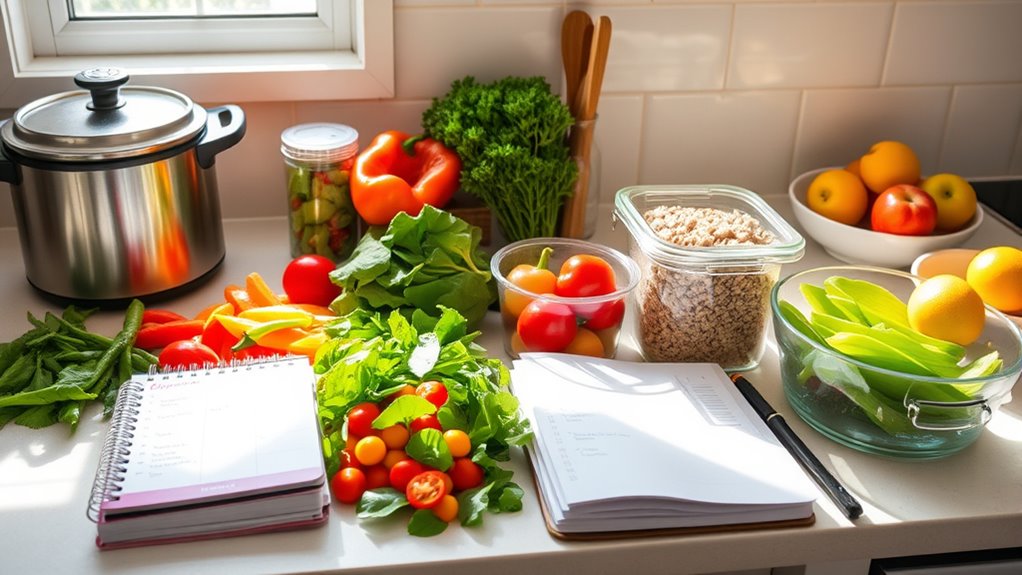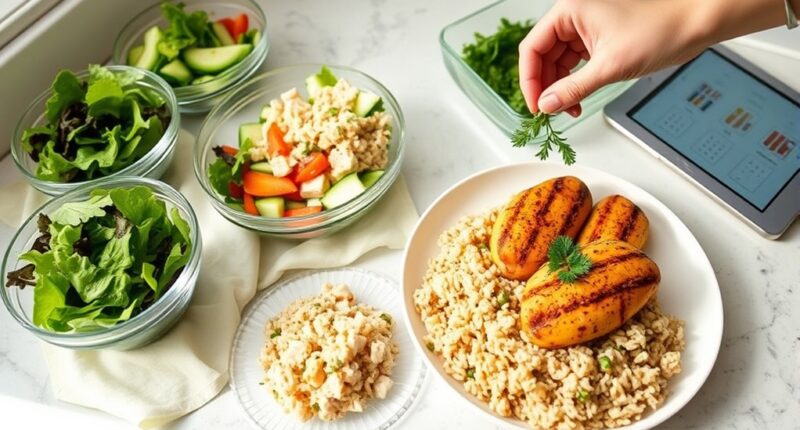To make healthy eating simple for busy families, start by creating a detailed grocery list based on planned meals. Organize the list by categories to shop efficiently and stick to it to avoid impulse buys. Prepare ingredients in advance, like washing vegetables and pre-cooking grains, to save time. Batch cooking and proper storage help stretch meals through the week. Keep your plan flexible and consistent, and you’ll find healthy eating becomes easier and less stressful—more tips are on the way.
Key Takeaways
- Plan meals weekly to ensure balanced, nutritious options tailored to your family’s preferences.
- Create a categorized grocery list to streamline shopping and prevent last-minute, unnecessary purchases.
- Batch cook and prep ingredients ahead of time for quick, healthy meals during busy weekdays.
- Stick to your shopping list and shop in one trip to save time and reduce food waste.
- Dedicate regular time for meal planning and storage to maintain a consistent, healthy eating routine.

Are you tired of last-minute dinner stress and wasted groceries? If so, you’re not alone. Juggling busy schedules while trying to eat healthily can feel overwhelming, but the key is simple: effective meal planning. It all starts with creating a solid grocery list. When you plan ahead, you avoid those frantic trips to the store, save money, and reduce food waste. Your grocery list becomes your roadmap, guiding you to buy only what you need and ensuring you have ingredients for nutritious meals throughout the week.
Effective meal planning starts with a solid grocery list, saving time, money, and reducing food waste.
To make this process smoother, incorporate some prep tips into your routine. Spend a little time each week organizing your grocery list based on your meal plan. Think about what dishes you want to prepare and jot down ingredients accordingly. Grouping items by categories—produce, dairy, grains—helps you shop faster and prevents forgetfulness. As you shop, stick to your list to resist impulse buys, which often lead to unnecessary expenses and food waste.
Once you’re home, prepping can be a game-changer. Wash and chop vegetables as soon as you bring them home, and portion out snacks or ingredients for specific meals. This way, when it’s time to cook, you already have some of the work done, making the process quicker and less stressful. Prepping tips like these also help you stick to your healthy eating goals because you’re less likely to reach for unhealthy convenience foods when your ingredients are ready to go.
Meal planning isn’t just about what to cook, but how to prepare so it fits into your busy life. Dedicate a small window of time each week, maybe Sunday afternoon, to map out your meals. Use your grocery list as a guide to purchase everything in one go. This approach prevents multiple trips to the store and the temptation to order takeout when you’re tired. Also, consider batch cooking or prepping ingredients for the week. For example, make a big pot of soup or cook grains in advance. Store these in airtight containers, so you can quickly assemble meals later.
Additionally, understanding the importance of effective storage can help you keep ingredients fresh longer and reduce waste. Finally, stay flexible. Your plan might need adjustments as your week unfolds, but having a framework in place keeps you on track. Remember, the goal is to make healthy eating manageable, not perfect. With a well-organized grocery list, smart prep tips, and a little planning, you’ll find yourself spending less time stressing over dinner and more time enjoying nutritious meals with your family.
Frequently Asked Questions
How Can I Involve Kids in Meal Planning?
You can involve your kids in meal planning by encouraging family involvement in choosing recipes and grocery shopping. Let them make age-appropriate choices, like selecting fruits or vegetables, to foster enthusiasm. Assign simple tasks such as setting the table or washing produce, making them feel valued and part of the process. This approach helps teach healthy eating habits and makes meal prep enjoyable for everyone.
What Are Quick Healthy Snack Ideas?
Think of yourself as a snack ninja, swiftly mastering healthy snack swaps and portable snack ideas. Grab a handful of mixed nuts, sliced veggies with hummus, or a piece of fruit paired with nut butter. These quick, nutritious options keep you energized and are easy to pack on the go. You’ll enjoy guilt-free snacking anytime, anywhere, making healthy choices effortless while staying busy.
How Do I Manage Meal Prep With Picky Eaters?
To manage meal prep with picky eaters, involve them in choosing and prepping meals, making them more invested. Offer vegetarian options and gluten-free recipes to cater to different tastes and dietary needs. Keep meals colorful and fun, and introduce new foods gradually. You can also create customizable bowls or wraps, allowing everyone to build their own meal. This approach keeps mealtime stress-free and encourages healthy eating habits.
What Are Budget-Friendly Healthy Meal Options?
You can save money by choosing affordable ingredients like beans, rice, oats, and frozen veggies. Incorporate these into your meals for nutritious, budget-friendly options. Use meal prep tips such as batch cooking and portioning to maximize savings and reduce waste. Planning weekly menus around sales and seasonal produce also helps keep costs low while ensuring healthy meals for your family.
How to Handle Dietary Restrictions in Meal Planning?
Dealing with dietary restrictions? Immerse yourself in diverse, delicious dishes by embracing gluten-free tips and vegetarian substitutions. For gluten sensitivities, choose naturally gluten-free grains like rice and quinoa, avoiding hidden gluten sources. Switch out meat with hearty beans or tofu for vegetarian needs. Planning proactively, label ingredients clearly, and explore specialty brands. With a little creativity, you can craft customizable, caring meals that cater to everyone’s dietary needs without sacrificing flavor or fun.
Conclusion
Now that you’ve mastered meal planning, you’re ready to reap the rewards of healthier habits and happier mealtimes. With a little planning, preparation, and persistence, you’ll prevent pantry panic and promote positive, productive eating. Remember, simple strategies can transform chaos into control, making mealtime more manageable and enjoyable. So, stay steadfast, stick to your schedule, and savor the success of streamlined, satisfying, and stress-free family feasts!









